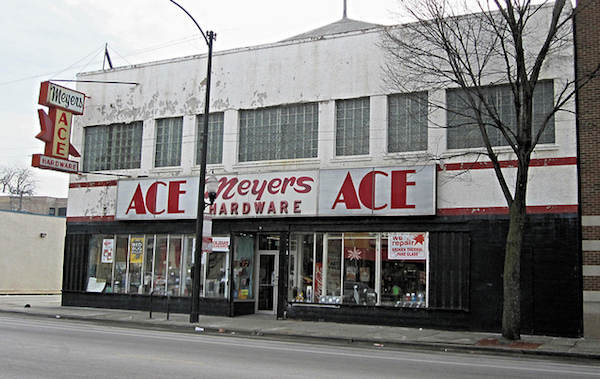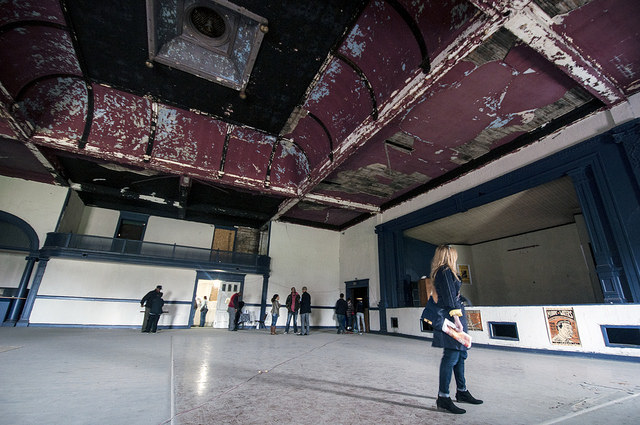Between 1923 and World War II, Chicago was the jazz capital of the world thanks to the Great Migration, which brought thousands of African Americans from the Deep South to the South Side. More than 70 nightclubs, ballrooms, and theatre halls lined the streets of Bronzeville—particularly along a stretch of State Street known as “the Stroll” from 31st to 39th Streets—where Nat King Cole, Louis Armstrong, Cab Calloway, Earl Hines, Jelly Roll Morton, and King Oliver all came of age, often in clubs owned and controlled by Al Capone.
Sadly, “the Stroll” was demolished after World War II to make way for Mies Van der Rohe’s Illinois Institute of Technology campus, and the grand venues on King Drive—the Regal Theatre and the Savoy Ballroom—were replaced by the Harold Washington Cultural Center. But if you know where to look, a few remnants of jazz’s golden age are still standing a few train stops south of the Chicago Jazz Festival this weekend.
Forum Hall
324 East 43rd Street
Built in 1889, the oldest hardwood-floor ballroom in Chicago sits at the corner of 43rd Street and Calumet Avenue. In the 1930s and ‘40s, it was a popular jazz venue with more dancing space than most nightclubs on “the Stroll.”
“I remember specifically that one of my first gigs was at the Forum Hall,” said Milton, the “Dean of Jazz Bass Players,” who would go on to tour with Cab Calloway and Dizzie Gillespie after meeting them here in Chicago, according to An Autobiography of Black Jazz by Dempsey J. Travis. “We used to play for a percentage of the gross receipts and I would carry my tuba and fiddle on the streetcar to that gig, which wasn’t very far from my house,” Milton said. Nat King Cole and Floyd Campbell played here, too, and on Monday, Wednesday, and Friday nights, the ballroom hosted a popular dance class.
After a brief appearance in the 1973 film The Sting (Robert Redford runs out of the first-floor bar in this clip), the Forum was shuttered and forgotten. In 2011, the city was a few days away from demolishing it when a Bronzeville organization called Urban Juncture stepped in to buy the building. It plans to convert the Forum into a mix of retail, hospitality, gallery, and performance space.
The Sunset Cafe
315 East 35th Street

Later renamed the Grand Terrace Cafe when Al Capone bought a 25 percent stake, this “black-and-tan” (integrated) jazz club was one of the most important venues in the history of music. It’s where Earl “Fatha” Hines and Louis Armstrong made a name for themselves playing duets in the mid-’20s. A few years later, it’s where Cab Calloway and Nat King Cole landed some of their first professional gigs alongside legends like Count Basie, Dizzy Gillespie, Charlie Parker, Sarah Vaughan, and even Benny Goodman.
Today, the building that once housed the Sunset/Grand Terrance is still standing, but up until last winter it was an Ace Hardware store. A plaque on the northeast corner marks the site as a Chicago landmark, which ensures the building won’t be demolished anytime soon. The old stage—beneath which Dizzy Gillespie would sometimes sleep to avoid being late for rehearsal—was converted into the store office. The murals are still on the walls of the office, so now that the hardware store has closed, there’s a chance new ownership will restore the artwork and open the building back up to the public.
Nat King Cole’s Three-Flat
4023 South Vincennes Avenue
Nathaniel Coles (he dropped the “s” as a teenager) was born in Alabama, but his family migrated to Chicago in 1923 when he was four years old, just as Louis Armstrong, Jelly Roll Morton, and Earl Hines were starting to draw crowds in Bronzeville. The Coles moved into this three-flat on Vincennes Avenue, just a few blocks east of “the Stroll.” Nat grew up watching Earl Hines play piano at the Regal, hearing Louis Armstrong play the trumpet at Bud Billiken picnics, and taking music classes at Wendell Phillips High School. “He had begun climbing out his bedroom window in the night,” Daniel Mark Epstein writes in Cole’s biography. “Now it was his turn to walk under the neon lights of ‘the Stroll’ and hear the music coming from the ‘black-and-tan’ cabarets.” From 1931 to 1936, Cole became a regular fixture on the Bronzeville circuit, establishing himself as a star by beating Earl Hines in a highly publicized Battle of the Bands at the Savoy Ballroom in 1935. Two years later, he left Chicago for Los Angeles, a newlywed at the ripe age of 17.
Louis Armstrong’s Greystone
421 East 44th Street
Louis Armstrong was nearly two decades older than Nat King Cole, so when the Coles family arrived in Chicago in 1923, Armstrong was already a member of King Oliver’s band at the Lincoln Gardens. Armstrong lived in this greystone just west of King Drive on 44th Street with his second wife, Lil Hardin Armstrong, another member of King Oliver’s band. “On warm summer afternoons, you could see Armstrong strolling through the alleys of Bronzeville in a white undershirt, khaki pants, white socks, and black slippers, carrying his trumpet case, the children following behind him like the Pied Piper,” Epstein writes. In 1926, Armstrong moved from the Lincoln Gardens to the Sunset Cafe, where he mentored a young Cab Calloway before leaving Chicago for New York a few years later.
Parkway Ballroom
4455 South King Drive
The Parkway Ballroom wasn’t around for the first wave of Chicago jazz in the 1920s and ’30s. By the time it was constructed in 1940, Nat King Cole, Louis Armstrong, and Cab Calloway had already skipped town for New York and L.A. The Grand Terrace Cafe closed a few months after the Parkway opened its doors, signaling the end of an era, and forcing Earl Hines to take his band on the road. But even though Bronzeville changed drastically over the next three decades, the music never left. The Parkway Ballroom was in many ways the successor to the Grand Terrace between 1940 and 1974, broadcasting radio shows and hosting Count Basie, Sarah Vaughan, and an older, traveling Nat King Cole. A local chef named Cliff Rome reopened the Parkway in 2002 as an event space for weddings, celebrations, and fundraisers, another example of Bronzeville’s gradual revitalization.



